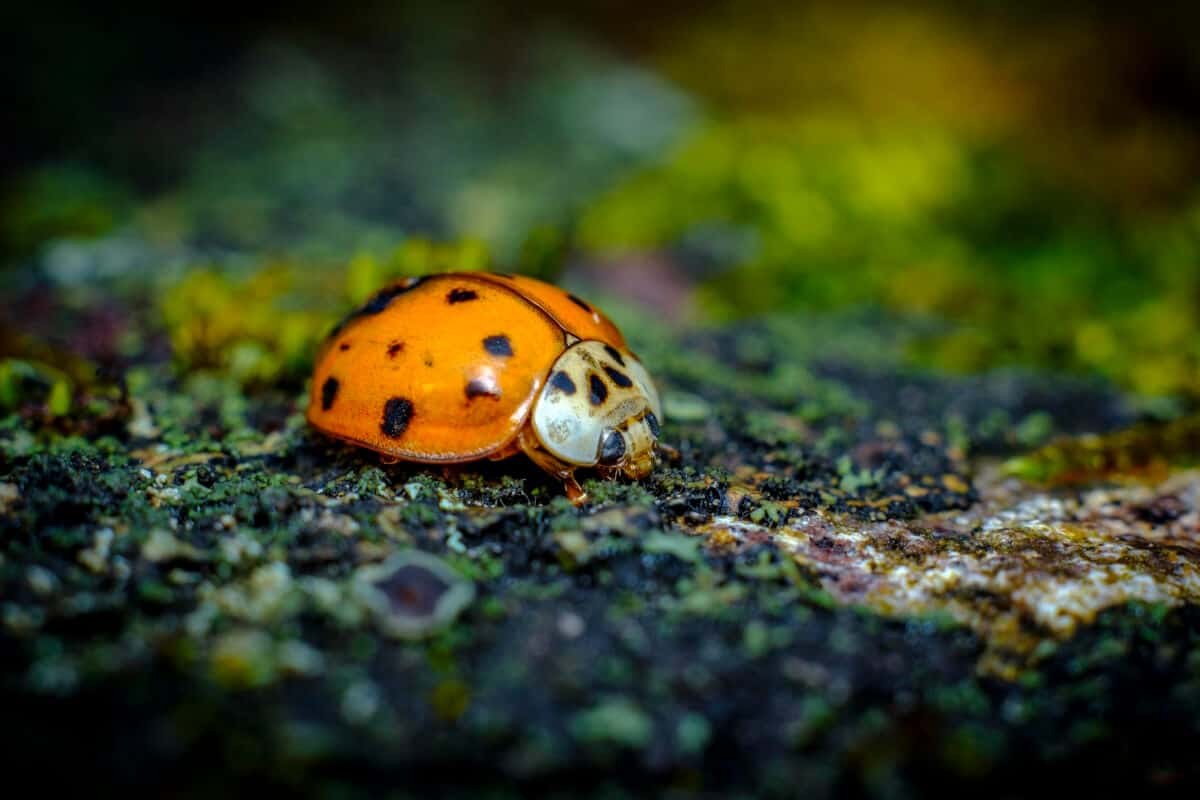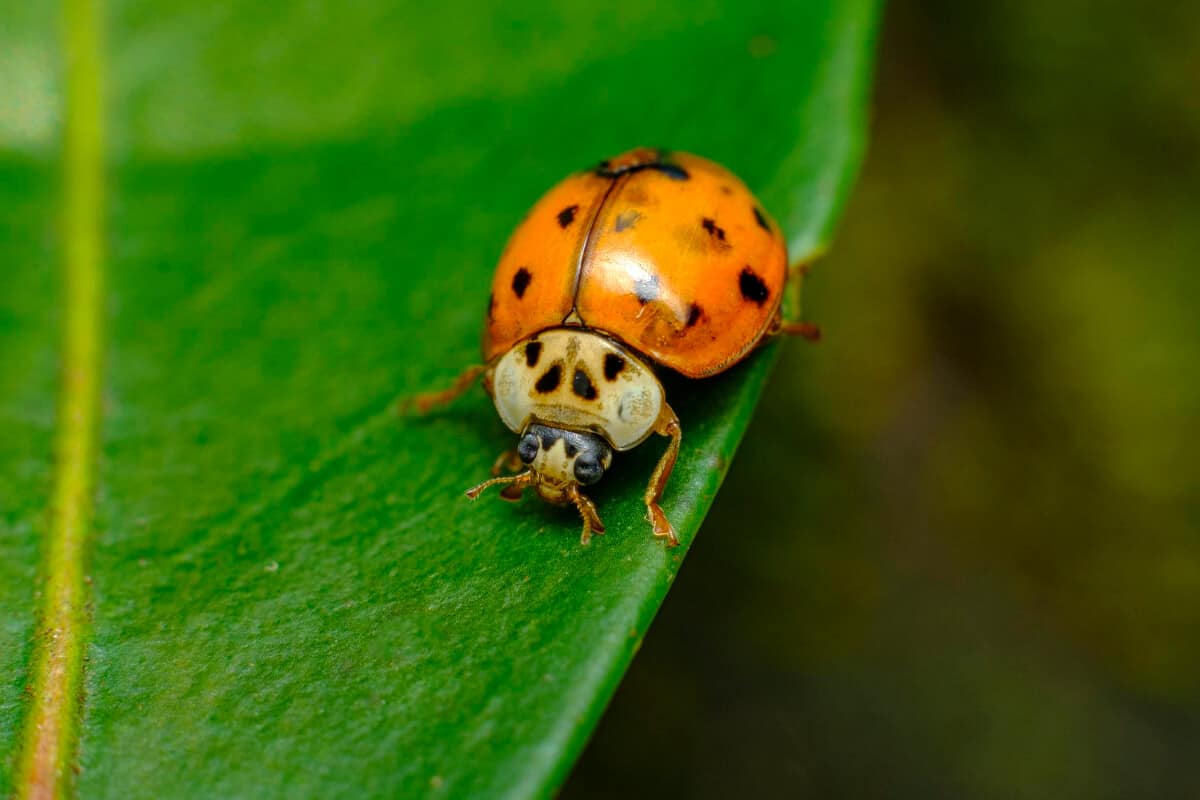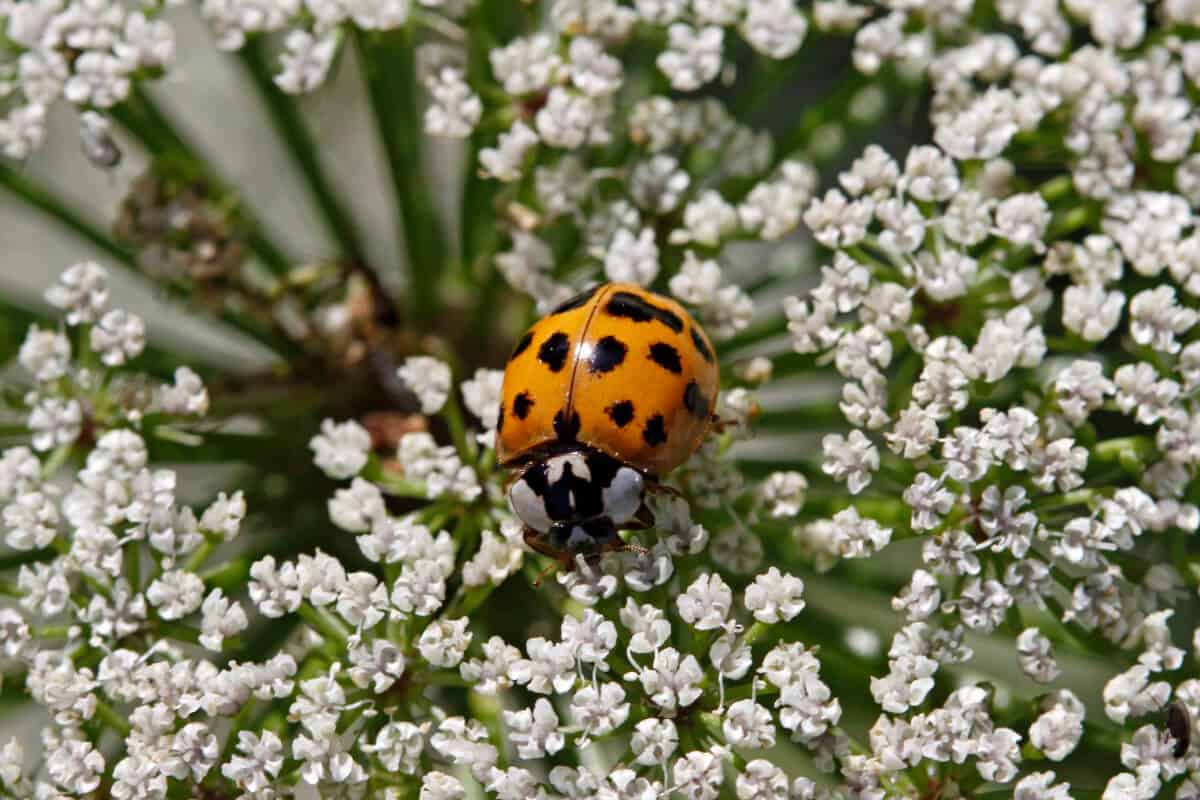It’s easy to confuse Asian Lady Beetles (Harmonia axyridis) for Ladybugs (Coccinella species). These Ladybug species are actually from the same insect family of beetles, which is Coccinellidae, so it’s understandable.
Many of these over 5,000 species in the Coccinellidae family are known as Ladybugs.
Asian Lady Beetles have evolved to disguise themselves almost perfectly as Ladybugs.
- Related article: Different Garden Insects
In this article, you will learn how to tell them apart with ease and why you need to do so.
What are Asian Lady Beetles and Ladybugs?

Lady Beetles or Ladybird Beetles are other names for Ladybugs.
The common Seven-spotted Ladybug is the most popular in North America, among the many different species of Ladybugs.
This ladybug species is actually native to Europe, but it was introduced in the USA during the last century.
These adorable Ladybugs are well-loved not only because they are pretty and harmless insects, but also because they are excellent pest killers.
They are beneficial insect predators that especially love pesky aphids, but also prey on mites, scale insects, and whiteflies. A single Ladybug can eat up to 5,000 insects in its lifetime.
Ladybugs are only active in spring and summer. During the colder season, they hibernate in warm, hidden places outdoors.
- Read more about Facts of Ladybugs.
The Asian Lady Beetle (Harmonia axyridis) is native to China, Russia, Korea, and Japan, which is why it’s newer than the common species of Ladybug in the United States.
The first populations of this beetle were discovered towards the end of the 1900s in the Southern part of the United States.
The Asian Lady Beetle is similar to the Ladybug in the sense that it also preys on garden pests.
In the past, there have been attempts to use this beetle as an agent for biological pest control.
What people didn’t realize at the time was that the Asian Beetle poses a huge threat to the American Ladybug. These native species were infested and out-competed by the Asian beetle.
It was eventually destroyed in many places. Nowadays, the Asian Lady Beetle is classified as an invasive species.
Asian Beetles vs Ladybugs: Key Differences

Asian Lady beetles and Ladybugs may look identical at first glance, but they can easily be distinguished with a bit of practice and observation.
The following are the main differences between these species:
1. Appearance: Color, Head, and Shape
The easiest way to tell the two species apart is by their physical characteristics.
Ladybugs are usually in bright colors of red with black spots most of the time, while Asian Lady Beetles can also be in light orange color.
The number of spots on Ladybugs can vary, but the most common one in the US has seven spots.
The head is the second most important clue: the head of a Ladybug is black with white markings on the sides and nowhere else.
On the other hand, Asian Lady Beetles are whitish on the back of the head.
You will be able to see a dark marking that is M- or W-shaped in this area if you look closely.
This pattern is a sure way of identifying them as it is always present in Asian Lady Beetles.
The insects also differ in body shape as Ladybugs are smaller and more rounded in shape than their Asian counterpart.
The shape of their heads is also slightly different as the Asian Beetles are longer and more pointed.
2. Behavior
Even though they look similar in appearance, Ladybugs and Asian Beetles have very different behaviors.
One of their main differences is constituted by their hibernation habits.
Ladybugs, as mentioned above, overwinter outdoors. Towards the end of the warm season, they look for sheltered natural hiding places.
Asian Lady Beetles can be a nuisance because they try to enter indoors during the fall or winter instead.
They are drawn to the warmth of our houses because they are used to milder winters in their native countries.
Windows and doors are attractive to these beetles as there’s light and they are brightly-colored areas in and around homes.
Once they manage to gain access indoors through cracks, wall spaces, or other small openings, they congregate in big groups which can completely take over dark places.
Their favorite hiding places are around window or door frames, as well as in attics, closets, and storage areas.
Another main difference is that when they feel threatened, Asian Lady Beetles excrete a foul-smelling yellow liquid on surfaces. This can also sometimes happen when they are crushed.
This smelly liquid is not dangerous unless you have allergic reactions, but it stains surfaces, such as walls and fabrics.
Asian Lady Beetles can also bite skin when they land on it. On the other hand, Ladybugs don’t excrete any substances and are not capable of biting.
3. Diet
Ladybugs are very useful insects in gardens as they feed on the true pest insects.
They are voracious predators of aphids, which are small, pesky plant-destroying insects that suck the sap from plants, damaging them.
Ladybugs also feed on mites, scale insects, and whiteflies.
It’s been reported that Ladybugs can also sometimes eat pollen if their preys are not present, but this is almost never the case in any kind of garden.
Asian Beetles, on the other hand, can feed from aphids, but they also often eat cultivated fruits. The most targeted are apples, grapes, and raspberries.
Even though these insects are only capable of infesting fruits that already have had their skin broken by other animals, they do make the situation worse.
Are Asian Beetles and Ladybugs Both Good for the Garden?

It’s well-known that Ladybugs are beneficial insects for the garden as they help to control pests that can cause great damage to crops and fruit production.
They are one of the most used agents of biological control, as, together with other beneficial insects, they enable farmers to minimize their use of toxic chemicals. These are usually effective, but can greatly harm the environment.
While Ladybugs are undoubtedly beneficial, the case with Asian Beetles is more complicated. While these beetles aren’t a huge problem for vegetable production, they have other negative effects to consider.
Asian Lady Beetles are a threat to the ecosystem as they diminish biodiversity by endangering local species. Because of their high reproductive rates, they compete heavily with local beetles for resources.
They also live much longer than them and their larvae can attack those of other insects.
The worse problem Asian Lady Beetles pose for humans is in the house.
As they seek a warm shelter during the winter season, they can invade houses and make it very difficult to open doors or windows as they can completely take them over and they bite if scared.
Another issue with having them in your house is that they can be a food reserve for rodents that might also seek shelter indoors.
How to Get Rid of Asian Beetles
It’s best to control Asian Lady Beetles if you don’t want them to invade your house and be a nuisance throughout the colder season, even if they aren’t a huge threat to you or your garden.
Completely eradicating them might not be the best idea, plus there are no insecticides that work against these beetles.
You will need to identify the places where they congregate in order to control the population of Asian Lady Beetles.
If you manage to find them as they are trying to enter the house, they will be on sun-exposed walls or windows.
You might also see them in the cracks of wooden frames or walls. Once you have located them, avoid crushing them as they bite when touched and often release a yellow, foul-smelling liquid.
The best tactic is to vacuum them and then throw the bag away. Also, remember to wash the surfaces where they congregated with soapy water.
Prevention, as is often the case, is the best solution. By sealing all entry points, you can make sure that Asian Lady Beetles won’t be able to enter the house.
Make sure you repair any structural damage as soon as possible, even the very small ones.
Ladybugs vs Asian Lady Beetles Final Thoughts
Both the Asian Beetle and the Ladybug are two fascinating creatures that share many similarities but also have several differences.
While both are beloved for their delicate and vibrant appearances, their behaviors, eating habits, and habitats are quite distinct.
The Asian Beetle might invade our homes during the fall season, and while they are harmless to humans, they are still a nuisance.
Ladybugs, on the other hand, are harmless, beneficial garden insects that prey on other pests such as aphids.
Overall, while both insects are essential in their unique ways, it’s crucial to know how to distinguish them and the purposes they serve to fully appreciate their contribution to our environment!
Take a look at these interesting articles to learn more about Ladybugs and Asian Lady Beetles:
Sources:
- https://uwm.edu/field-station/seven-spotted-ladybug/
- https://extension.unh.edu/blog/2019/10/how-can-i-get-rid-asian-ladybugs-my-house
- http://entomology.ca.uky.edu/ef416

